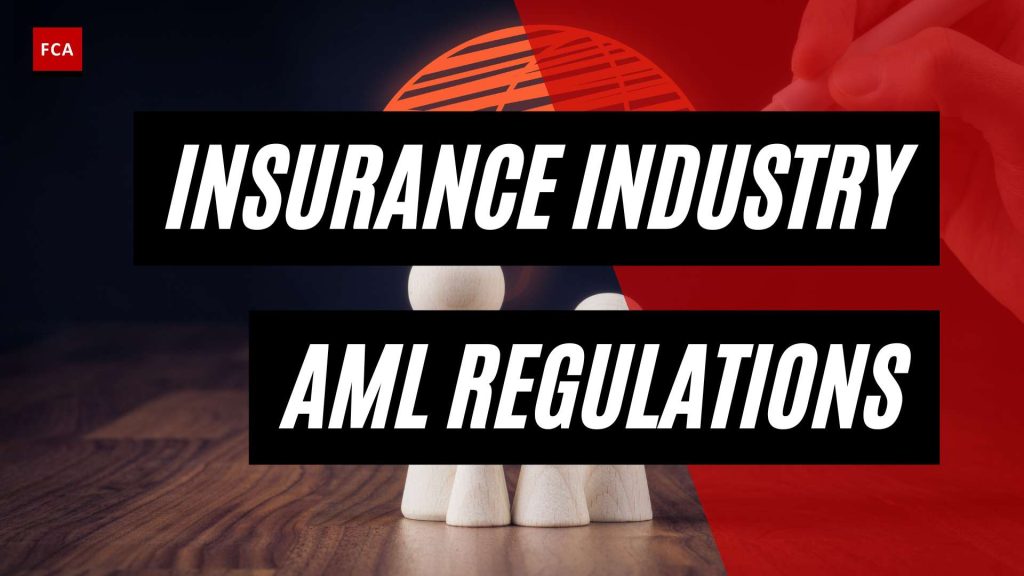Understanding AML in the Insurance Industry
In the world of insurance, it is crucial to have a solid understanding of Anti-Money Laundering (AML) regulations and their implications. This section will provide an overview of AML regulations in the insurance industry and shed light on the role of state insurance departments.
Overview of AML Regulations in Insurance
Unlike other financial institutions, insurance companies are not considered subject to the AML requirements of the USA PATRIOT Act. However, this does not mean that they are exempt from AML compliance considerations. AML compliance for insurance companies is embedded within the system of state-administered insurance regulation (NAIC). State insurance departments play a crucial role in overseeing the anti-fraud functions of insurance companies and ensuring compliance with AML regulations.
While insurance regulatory compliance functions are generally exempted from the federal Bank Secrecy Act, insurance companies must still comply with the requirements of the USA PATRIOT Act (NAIC). This means that insurance companies need to have measures in place to prevent money laundering and other illicit activities within their operations.
Role of State Insurance Departments
State insurance departments are responsible for overseeing the anti-fraud functions of insurance companies. These departments are actively involved in monitoring compliance with AML regulations and ensuring that insurance companies implement effective fraud prevention measures. While each state may have specific regulations and requirements, the overarching objective remains the same – to protect consumers and maintain the integrity of the insurance industry.
State insurance departments also play a crucial role in investigating and prosecuting insurance fraud. They work closely with law enforcement agencies and other regulatory bodies to identify and address instances of money laundering or other fraudulent activities within the insurance sector. By enforcing anti-fraud laws and regulations, state insurance departments contribute to the overall stability and trustworthiness of the insurance industry.
It is worth noting that jurisdictions without dedicated insurance regulators are encouraged to adopt and implement anti-fraud models similar to those established by the National Association of Insurance Commissioners (NAIC). This helps control insurance fraud and ensures a consistent approach to combating money laundering and other illicit activities within the insurance industry (NAIC).
In the next section, we will explore the specific AML compliance requirements that insurance companies must adhere to. Stay tuned to learn more about the measures taken to prevent money laundering and mitigate AML risks in the insurance sector.
AML Compliance in the Insurance Sector
To combat the risk of money laundering and the financing of terrorist activities, the insurance sector is subject to specific Anti-Money Laundering (AML) compliance requirements. Insurance companies play a vital role in preventing their use as facilitators of illicit activities. This section will discuss the AML compliance requirements for insurance companies and the challenges they face in implementing effective AML programs.
AML Compliance Requirements for Insurance Companies
Insurance companies are mandated to develop and implement written AML programs to prevent their involvement in money laundering or terrorist financing activities. According to 31 CFR § 1025.210, these programs should be approved by senior management and made available to the Department of the Treasury or the Financial Crimes Enforcement Network upon request.
Key requirements for AML compliance in the insurance sector include:
-
Risk Assessment: Insurance companies must assess the money laundering and terrorist financing risks associated with their covered products. The AML program should be based on this assessment to ensure it effectively addresses the identified risks.
-
Policies, Procedures, and Internal Controls: Insurance companies are required to establish and implement policies, procedures, and internal controls that comply with relevant AML requirements. These measures should integrate insurance agents and brokers, obtain necessary customer-related information, and facilitate the effective implementation of the AML program.
-
Compliance Officer: It is essential for insurance companies to designate a compliance officer responsible for overseeing the implementation of the AML program. This officer is responsible for updating the program as necessary, ensuring appropriate education and training, and maintaining effective communication with relevant individuals.
-
Education and Training: Ongoing training of relevant individuals is crucial to ensure their understanding of their responsibilities under the AML program. Insurance companies can provide direct training, verify training conducted by another insurance company, or utilize competent third parties to deliver the necessary education and training.
-
Independent Testing: Insurance companies must conduct periodic independent testing to monitor and maintain the effectiveness of their AML programs. This testing should include an assessment of the compliance of insurance agents and brokers. The scope and frequency of testing should be proportionate to the risks associated with the company’s covered products.
AML Compliance Challenges in Insurance
Implementing effective AML programs in the insurance sector comes with its own set of challenges. Some common challenges faced by insurance companies include:
-
Complexity of Products and Transactions: Insurance products often involve complex structures and transactions, making it challenging to identify potential money laundering risks. The diverse range of insurance offerings, such as life insurance, property and casualty insurance, and annuities, necessitates careful scrutiny to detect suspicious activities.
-
Integration of Insurance Agents and Brokers: Insurance companies rely on a network of agents and brokers to distribute their products. Ensuring the compliance of these intermediaries with AML regulations can be challenging. It requires effective communication, training, and monitoring to maintain a strong AML framework across the entire distribution network.
-
Customer Due Diligence (CDD): Conducting thorough customer due diligence can be complex in the insurance sector. Insurance companies need to gather and verify customer-related information, assess the source of funds, and identify beneficial owners. The extensive nature of these requirements can pose challenges, especially when dealing with large volumes of customers and policyholders.
-
Technological Advancements: The rapid evolution of technology in the insurance industry presents both opportunities and challenges for AML compliance. Insurance companies need to stay updated with technological advancements to detect and prevent money laundering activities effectively. However, it also requires continuous investment in robust AML software and systems to keep pace with emerging risks.
By understanding the AML compliance requirements and addressing the associated challenges, insurance companies can play a crucial role in the global fight against money laundering and terrorist financing. Implementing robust AML programs not only helps protect the integrity of the insurance industry but also contributes to the overall stability of the financial system.
AML Regulations in Different Jurisdictions
Anti-Money Laundering (AML) regulations play a crucial role in combating financial crimes within the insurance industry. These regulations vary across different jurisdictions, with international bodies and local authorities implementing guidelines to ensure compliance. In this section, we will explore the AML regulations in various jurisdictions, including international regulatory bodies, the United States, the European Union, Singapore, and Australia.
International AML Regulatory Bodies
At the forefront of establishing global AML compliance standards, the Financial Action Task Force (FATF) serves as an international organization with 37 member jurisdictions (Flagright). The FATF’s primary objective is to prevent money laundering and terrorism financing by providing recommendations and overseeing their effective implementation. Their guidelines and recommendations serve as a benchmark for AML regulations across the globe.
AML Regulations in the United States
In the United States, the Bank Secrecy Act (BSA) is the primary legislation addressing AML concerns. Enforced by the Financial Crimes Enforcement Network (FinCEN), the BSA imposes obligations on financial institutions, including insurance companies, to establish robust AML programs and report suspicious transactions. Non-compliance with the BSA can result in severe penalties, including imprisonment and fines of up to $250,000 (Flagright).
AML Regulations in the European Union
The European Union has implemented several directives to combat money laundering and terrorism financing. The Fifth Anti-Money Laundering Directive (5AMLD), published in 2018, and the subsequent Sixth Anti-Money Laundering Directive (6AMLD) aim to prevent financial crimes globally while promoting the integrity and growth of the financial system. These directives establish obligations for member states to enhance AML controls, conduct risk assessments, and strengthen customer due diligence measures within the insurance sector.
AML Regulations in Singapore
Singapore has a robust regulatory framework to combat money laundering and terrorism financing. The Monetary Authority of Singapore (MAS) is the primary regulatory authority overseeing AML compliance in the country’s financial sector, including insurance. The MAS requires financial institutions to implement effective AML policies and procedures, conduct risk assessments, and establish robust internal controls to detect and prevent financial crimes.
AML Regulations in Australia
In Australia, the Australian Transaction Reports and Analysis Centre (AUSTRAC) is the primary financial intelligence agency responsible for countering money laundering, terrorism financing, and other financial crimes. The Anti-Money Laundering and Counter-Terrorism Financing Act (2006) empowers AUSTRAC to enforce AML regulations in the country. Insurance companies in Australia are required to comply with these regulations, including reporting suspicious transactions and conducting customer due diligence.
By understanding the AML regulations in different jurisdictions, insurance companies can navigate the complex landscape and ensure compliance with local and international guidelines. It is essential for insurance professionals to stay up-to-date with these regulations and implement robust AML programs to mitigate the risks associated with money laundering and protect the integrity of the insurance industry.
For more information on AML compliance in insurance, explore our articles on aml training for insurance agents, anti-money laundering in insurance sector, and aml risk assessment in insurance.
AML Risks and Red Flags in Insurance
In the insurance industry, there are inherent risks associated with money laundering due to its vast, diversified, and prosperous nature. Criminals often exploit the disconnection between independent agents or brokers and the insurance firms they represent, making the industry vulnerable to money laundering activities. This disconnection can result in agents and brokers being unaware of the importance of screening clients and questioning payment methods, potentially leading to collaboration with criminals for money laundering purposes (Sanction Scanner).
Money Laundering Risks in the Insurance Industry
Life insurance packages, in particular, are susceptible to money laundering. The significant sums of money involved in life insurance policies make them an attractive target for money launderers. The large amounts of money involved in these policies fulfill the needs of money launderers, thus posing a higher risk within the life insurance sector (Sanction Scanner).
To effectively manage money laundering risks in the insurance industry, it is important for insurance professionals to be vigilant for potentially suspicious activities. While it is not their responsibility to determine if the transactions are linked to financial crimes, reporting such activities is crucial. Suspicious activities that may indicate money laundering or terrorism funding include:
- Clients providing false or inconsistent information during the application process.
- Frequent changes in policy ownership or beneficiary designations without valid reasons.
- Large premium payments made in cash or through third-party intermediaries.
- Policies that involve unusually high coverage amounts.
- Clients who exhibit little to no interest in the policy’s details or benefits.
- Unexplained sources of funds used for premium payments (Sanction Scanner).
Red Flags for Money Laundering in Insurance
To enhance AML compliance in the insurance industry, it is important for insurance companies and professionals to be aware of red flags that may indicate potential money laundering activities. Some common red flags include:
- Frequent policy cancellations and reinstatements without valid reasons.
- Clients who request changes to their policy shortly after its inception without reasonable explanations.
- Multiple policies purchased by the same individual or entity with no apparent need.
- Clients who maintain policies with no clear insurable interest.
- Premium payments made from high-risk jurisdictions or through offshore accounts.
- Unexplained transfers of policy ownership without a legitimate purpose (Sanction Scanner).
By remaining vigilant and recognizing these red flags, insurance professionals can play a crucial role in detecting and preventing money laundering activities within the industry. Implementing robust Know Your Customer (KYC) procedures and regularly conducting customer due diligence (CDD) are essential for identifying potential risks and ensuring compliance with AML regulations. It is crucial for insurance companies to have comprehensive AML policies, provide appropriate AML training for insurance professionals, and utilize advanced AML software to strengthen their AML compliance efforts and protect the integrity of the industry as a whole.
Implementing AML Compliance in Insurance
To effectively combat money laundering and comply with AML regulations, insurance companies must establish robust procedures and systems. This section will explore key components of AML compliance implementation in the insurance industry, including Know Your Customer (KYC) procedures, Customer Due Diligence (CDD), and ongoing monitoring and reporting.
Know Your Customer (KYC) Procedures
Implementing strong KYC procedures is crucial for insurance companies to verify the identity of policyholders and detect any potential risks associated with money laundering or terrorist financing. KYC procedures involve gathering essential information about customers and assessing their risk profiles. This allows insurance companies to identify and mitigate potential risks before entering into any business relationships.
Key elements of effective KYC procedures in the insurance industry include:
- Customer Identification: Insurance companies need to collect and verify customer identification documents, such as passports or driver’s licenses, to establish their true identities.
- Risk Assessment: Companies must conduct risk assessments to determine the level of due diligence required for each customer. Risk factors may include the nature of the insurance product, the customer’s country of residence, or their occupation.
- Enhanced Due Diligence (EDD): In cases where higher risks are identified, insurance companies should conduct enhanced due diligence measures. EDD may involve obtaining additional information, such as the source of funds or wealth, and conducting ongoing monitoring of the customer’s transactions.
- Sanctions Screening: Insurance companies should screen customers against international sanctions lists to ensure they are not involved in any prohibited activities or associated with sanctioned individuals or entities.
By implementing robust KYC procedures, insurance companies can minimize the risk of facilitating money laundering activities and protect the integrity of their operations. For more information on AML training for insurance professionals, refer to our article on aml training for insurance professionals.
Customer Due Diligence (CDD) in Insurance
Customer Due Diligence (CDD) is an essential process in AML compliance for insurance companies. CDD involves gathering information about the customer’s identity, beneficial ownership, and understanding the nature of their insurance needs and transactions. The purpose of CDD is to assess the risk profile of the customer and ensure that insurance products are not being misused for illicit purposes.
Key aspects of CDD in the insurance industry include:
- Identification of Beneficial Owners: Insurance companies must identify and verify the beneficial owners of policies, especially in cases where the policyholder is not the ultimate beneficiary or where there are complex ownership structures.
- Risk-Based Approach: CDD measures should be commensurate with the level of risk associated with the customer. High-risk customers may require additional due diligence, while low-risk customers may undergo simplified due diligence.
- Ongoing Monitoring: Insurance companies should monitor customer transactions and activities on an ongoing basis to detect any suspicious behavior or changes in risk profiles. This includes reviewing policy renewals, claims, and transaction patterns.
By implementing effective CDD procedures, insurance companies can identify and prevent potential money laundering activities, safeguarding their operations and reputation. For more information on AML policies for insurance companies, refer to our article on aml policies for insurance companies.
Ongoing Monitoring and Reporting
Ongoing monitoring is a critical element of AML compliance in the insurance industry. Insurance companies need to continuously monitor customer transactions and activities to identify any unusual patterns or suspicious behavior that may indicate potential money laundering or terrorist financing.
Key aspects of ongoing monitoring and reporting include:
- Transaction Monitoring: Insurance companies should establish systems to monitor customer transactions in real-time. This allows them to identify any deviations from normal behavior or patterns that may indicate money laundering activities.
- Suspicious Activity Reporting: If insurance companies identify any suspicious transactions or activities, they must promptly report them to the appropriate authorities. This helps in the detection and prevention of financial crimes.
- Record-Keeping: Insurance companies are required to maintain comprehensive records of customer transactions and due diligence activities. These records can assist in investigations and audits, demonstrating compliance with AML regulations.
By implementing robust ongoing monitoring and reporting mechanisms, insurance companies can promptly detect and report any potential money laundering activities, contributing to the overall integrity of the financial system. For more information on AML software for insurance companies, refer to our article on aml software for insurance companies.
Consequences of Non-Compliance
Ensuring compliance with anti-money laundering (AML) regulations is of utmost importance for insurance companies. Failing to comply with these regulations can result in severe consequences, both in terms of penalties and reputational damage. Let’s explore the penalties for AML non-compliance and the importance of AML compliance in the insurance industry.
Penalties for AML Non-Compliance
Non-compliance with AML laws and regulations in the United States can lead to criminal and civil charges, fines, jail sentences, reputational harm, and loss of assets and funds associated with illegal operations. Under the Bank Secrecy Act (BSA), fines imposed for various violations range from $10,000 to $100,000 per day (Sanction Scanner). These penalties serve as a deterrent to ensure that insurance companies adhere to AML compliance requirements.
It’s crucial for insurance companies to establish effective AML compliance programs, including robust Know Your Customer (KYC) procedures, customer due diligence (CDD) measures, and ongoing monitoring and reporting mechanisms. By implementing these practices, insurance companies can minimize the risk of non-compliance and avoid the potential financial and legal consequences.
Importance of AML Compliance in Insurance
The insurance industry, with its vast and prosperous nature, is vulnerable to money laundering activities. Criminals often exploit the disconnection between independent agents or brokers and the insurance firms they represent. This disconnection can lead to agents and brokers being unaware of the importance of screening clients and questioning payment methods, potentially resulting in collaboration with criminals for money laundering purposes (Sanction Scanner).
Compliance with AML regulations is crucial for insurance companies to protect the integrity of their organization and prevent unauthorized transactions involving illegal funds. By implementing effective best practices for KYC compliance rules, such as vetting customers against accessible databases for any links to criminal activity or corruption, reporting suspicious individuals to top management and compliance officers, and ensuring compliance with BSA requirements, insurance companies can mitigate the risks associated with money laundering and maintain the trust of their stakeholders (Sanction Scanner).
Furthermore, complying with AML regulations is essential for insurance companies to meet their obligations under insurance sanctions and prevent financial crimes, including money laundering and terrorism funding. Establishing robust AML compliance programs, incorporating risk-based measures, and adhering to AML regulatory standards worldwide help insurance companies safeguard their operations and contribute to the overall integrity of the financial system (Sanction Scanner).
In conclusion, the consequences of non-compliance with AML regulations in the insurance industry can be severe. Insurance companies must prioritize AML compliance to avoid penalties, protect their reputation, and contribute to the fight against financial crimes. By implementing comprehensive AML compliance programs, insurance companies can demonstrate their commitment to maintaining a secure and trustworthy financial environment.








